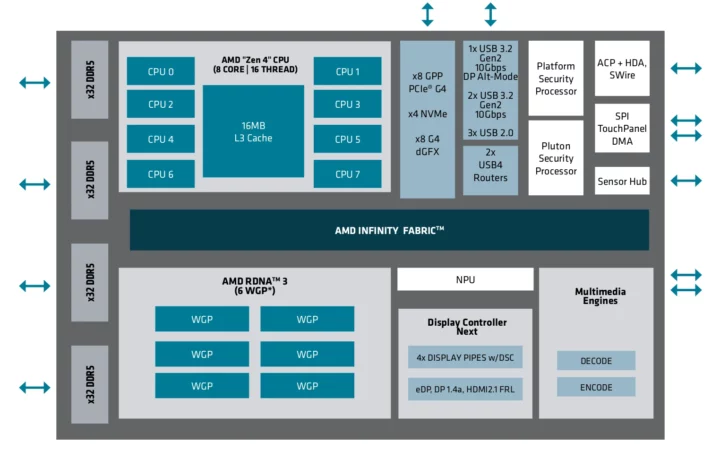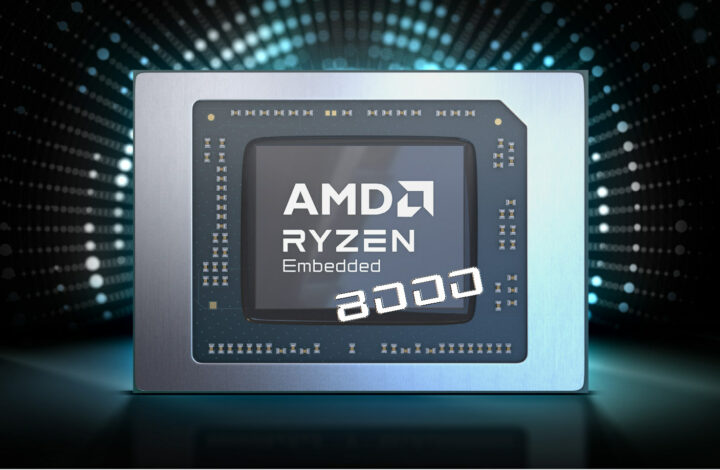AMD has recently “announced” the Ryzen Embedded 8000 Series processors in a community post with the latest AMD embedded devices combining a 16 TOPS NPU based on the AMD XDNA architecture with CPU and GPU elements for a total of 39 TOPS designed for industrial artificial intelligence.
The Ryzen Embedded 8000 CPUs will be found in machine vision, robotics, and industrial automation applications to enhance the quality control and inspection processes, enable real-time, route-planning decisions on-device for minimal latency, and predictive maintenance, and autonomous control of industrial processes.
AMD Ryzen Embedded 8000 key features and shared specifications:
- CPU – Up to 8 “Zen 4” cores, 16 threads
- Cache
- L1 Instruction Cache – 32 KB, L1 Data Cache = 32 KB (per core)
L2 Cache – Up to 8 MB (total) - L3 Cache- Up to 16 MB unified
- L1 Instruction Cache – 32 KB, L1 Data Cache = 32 KB (per core)
- Graphics – RDNA 3 graphics with up to 6 WGPs (Work Group processors)
- Multimedia engine for AV1, H.264, and H.265 video encode and decode
- NPU – 16 TOPS
- Sensor hub
- Memory – 128bit DDR5-5600 with ECC
- Video Output
- eDP, DP 1.4a, HDMI 2.1
- SPI touchpanel
- Up to 4x independent 4K displays
- Audio – ACP + HDA, SoundWire
- USB
- 2x USB4 Type-C with DP Alt-mode
- 1x USB 3.2 Gen2 10Gb/s Type-C DP Alt-mode
- 1x USB 3.2 Gen2 10Gb/s
- 3x USB 2.0
- 1x USB 2.0 (SecureBio dedicated)
- Expansion – x20 PCIe Gen4
- Security – Microsoft Pluton and Platform Security processors to provide fTPM 2.0 and additional security features
- Package – 35x 25 x 1.38 mm Lidless BGA, 0.64mm min ball pitch; FP7r2 (DDR5) with 1,140 balls
- Process – TSMC 4nm

Four SKUs are currently available with the Ryzen Embedded 8845HS, 8645HS, 8840U, and 8640U all equipped with 16MB L2 cache and RDNA 3 graphics, supporting 5600 MT/s DDR5 memory, and offered with a 10-year extended longevity commitment. They differ in terms of TDP, CPU clocks, L2 cache size, and number of graphics working groups.
| Model | Embedded OPN | TDP | Cores/Threads | CPU Base Freq (GHz) | CPU Boost Freq. (GHz) | L2 cache (MB) | Graphics WGPs |
|---|---|---|---|---|---|---|---|
| Ryzen Embedded 8845HS | 100-000001316E | 45W (35 to 54W) | 8/16 | 3.8 | 5.1 | 8 | 6 |
| Ryzen Embedded 8645HS | 100-000001315E | 45W (35 to 54W) | 6/12 | 4.3 | 5.0 | 6 | 4 |
| Ryzen Embedded 8840U | 100-000001317E | 28W (15 to 30W) | 8/16 | 3.3 | 5.1 | 8 | 6 |
| Ryzen Embedded 8640U | 100-000001318E | 28W (15 to 30W) | 6/12 | 3.5 | 4.9 | 6 | 4 |
AMD says the new Ryzen Embedded 8000 processors are supported by open, royalty-free software libraries and inferencing models, as well as a software development kit (SDK) currently available for Windows only. Supported AI frameworks include PyTorch and TensorFlow with pre-trained models available on HuggingFace.
The first systems based on the new AMD Ryzen Embedded processor will come from Advantech, ASRock, and iBASE. Additional information and developer resources can be found on the product page.
Thanks to Anonymous for the tip.

Jean-Luc started CNX Software in 2010 as a part-time endeavor, before quitting his job as a software engineering manager, and starting to write daily news, and reviews full time later in 2011.
Support CNX Software! Donate via cryptocurrencies, become a Patron on Patreon, or purchase goods on Amazon or Aliexpress






AMD now also with a built-in NPU? Is this the first CPU with that? Or did I miss earlier announcements on other AMD CPU’s?
Its not new, i just bought a Ryzen 7 8700G and it also has a NPU.
These new embedded versions seem quite similar.
“Phoenix” APUs had a 10 TOPS NPU (XDNA 1.0) when they launched in early 2023.
AMD paper launched “Hawk Point” APUs at the end of 2023, available for a couple of months now. They are a minor refresh of Phoenix, with the most notable change being increased NPU performance to 16 TOPS simply from increasing clock speeds, as it’s still the same XDNA 1.0 silicon.
AMD desktop APUs based on Hawk Point were launched on January 31, 2024. The 8700G and 8600G include the 16 TOPS NPU, while the 8500G and 8300G (OEM-only, coming to retail later) are based on a smaller “Phoenix2” die with no NPU included. Phoenix2 chips could conceivably be dual sourced by disabling Phoenix/Hawk dies.
AMD’s next generation of APUs, Strix Point, are expected to include a mix of up to 12x Zen 5/5c cores,16 CUs of RDNA 3+ (also called RDNA 3.5) graphics, and an XDNA 2.0 NPU with performance roughly tripled to around 45-50 TOPS. They should be launched around Q3 or Q4. In addition, a more powerful “Strix Halo” and a less powerful “Kraken Point” (smaller 8-core die) should also include the same XDNA 2.0 silicon and 45-50 TOPS performance. But those are likely launching in 2025.
About the “16 TOPS NPU”:
“For the <Intel> Ultra 7 165H chip, you get roughly up to 34 TOPS with 11 TOPS for the NPU, 18 TOPS for the GPU and the rest for the CPU. ”
So this AMD is peforming better?
I’m not sure that Intel has put out an official TOPS number for Meteor Lake. It’s around 10 TOPS. Yes, AMD is performing better with Hawk Point at 16 TOPS.
I see these initial x86 NPUs as getting the foot in the door so developers can start working with them. 16 vs. 10 TOPS doesn’t really matter. What does matter is the next generation. Both AMD (Strix Point) and Qualcomm (Snapdragon X Elite) will include a ~45 TOPS NPU, meeting a Windows “requirement” of 40 TOPS for running Copilot locally, without needing to use the iGPU/CPU.
Intel is expected to triple NPU performance with Arrow Lake and Lunar Lake (30 TOPS?) and almost double it again with Panther Lake (50-60 TOPS?).
tomshardware.com/pc-components/cpus/intel-makes-a-big-ai-push-with-future-cpus-panther-lake-in-2025-will-double-the-ai-performance-over-arrow-lake-and-lunar-lake
Cool. Thanks for the explanation